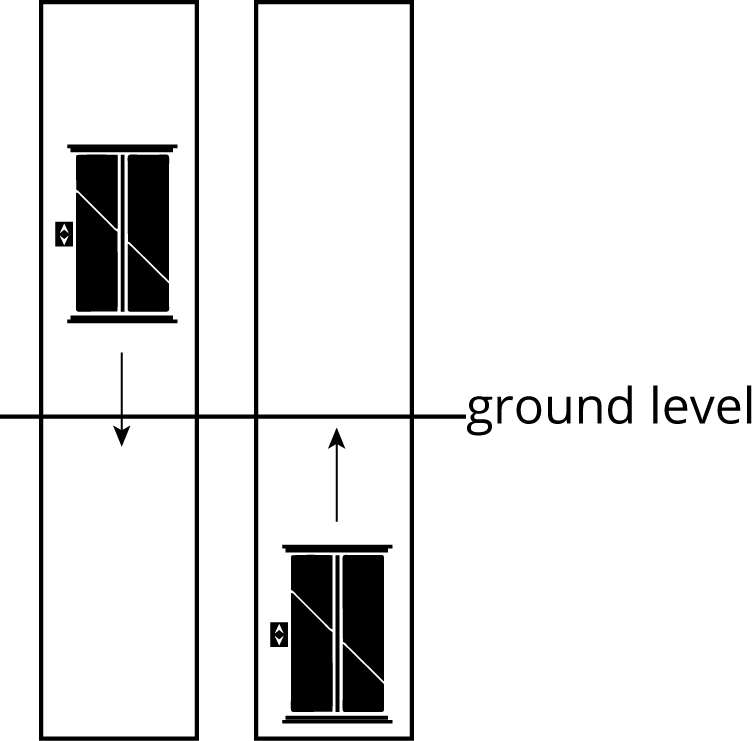Lesson 17
When Are They the Same?
Let’s use equations to think about situations.
17.1: Which Would You Choose?
If you were babysitting, would you rather
- Charge $5 for the first hour and $8 for each additional hour?
Or
- Charge $15 for the first hour and $6 for each additional hour?
Explain your reasoning.
17.2: Water Tanks
The amount of water in two tanks every 5 minutes is shown in the table.
| time (minutes) | tank 1 (liters) | tank 2 (liters) |
|---|---|---|
| 0 | 25 | 1000 |
| 5 | 175 | 900 |
| 10 | 325 | 800 |
| 15 | 475 | 700 |
| 20 | 625 | 600 |
| 25 | 775 | 500 |
| 30 | 925 | 400 |
| 35 | 1075 | 300 |
| 40 | 1225 | 200 |
| 45 | 1375 | 100 |
| 50 | 1525 | 0 |
- Describe what is happening in each tank. Either draw a picture, say it verbally, or write a few sentences.
- Use the table to estimate when the tanks will have the same amount of water.
- The amount of water (in liters) in tank 1 after \(t\) minutes is \(30t + 25\). The amount of water (in liters) in tank 2 after \(t\) minutes is \( \text-20t + 1000\). Find the time when the amount of water will be equal.
17.3: Elevators
A building has two elevators that both go above and below ground.
At a certain time of day, the travel time it takes elevator A to reach height \(h\) in meters is \(0.8 h + 16\) seconds.
The travel time it takes elevator B to reach height \(h\) in meters is \(\text-0.8 h + 12\) seconds.

- What is the height of each elevator at this time?
- How long would it take each elevator to reach ground level at this time?
- If the two elevators travel toward one another, at what height do they pass each other? How long would it take?
- If you are on an underground parking level 14 meters below ground, which elevator would reach you first?
- In a two-digit number, the ones digit is twice the tens digit. If the digits are reversed, the new number is 36 more than the original number. Find the number.
- The sum of the digits of a two-digit number is 11. If the digits are reversed, the new number is 45 less than the original number. Find the number.
- The sum of the digits in a two-digit number is 8. The value of the number is 4 less than 5 times the ones digit. Find the number.
Summary
Imagine a full 1,500 liter water tank that springs a leak, losing 2 liters per minute. We could represent the number of liters left in the tank with the expression \(\text-2x+1,\!500\), where \(x\) represents the number of minutes the tank has been leaking.
Now imagine at the same time, a second tank has 300 liters and is being filled at a rate of 6 liters per minute. We could represent the amount of water in liters in this second tank with the expression \(6x+300\), where \(x\) represents the number of minutes that have passed.
Since one tank is losing water and the other is gaining water, at some point they will have the same amount of water—but when? Asking when the two tanks have the same number of liters is the same as asking when \(\text-2x+1,\!500\) (the number of liters in the first tank after \(x\) minutes) is equal to \(6x+300\) (the number of liters in the second tank after \(x\) minutes),
\(\text-2x+1,\!500=6x+300.\)
Solving for \(x\) gives us \(x=150\) minutes. So after 150 minutes, the number of liters of the first tank is equal to the number of liters of the second tank. But how much water is actually in each tank at that time? Since both tanks have the same number of liters after 150 minutes, we could substitute \(x=150\) minutes into either expression.
Using the expression for the first tank, we get \(\text-2(150)+1,\!500\) which is equal to \(\text-300+1,\!500\), or 1,200 liters.
If we use the expression for the second tank, we get \(6(150)+300\), or just \(900+300\), which is also 1,200 liters. That means that after 150 minutes, each tank has 1,200 liters.
Glossary Entries
- coefficient
A coefficient is a number that is multiplied by a variable.
For example, in the expression \(3x+5\), the coefficient of \(x\) is 3. In the expression \(y+5\), the coefficient of \(y\) is 1, because \(y=1 \boldcdot y\).
- constant term
In an expression like \(5x+2\), the number 2 is called the constant term because it doesn’t change when \(x\) changes.
In the expression \(7x+9\), 9 is the constant term.
In the expression \(5x+(\text-8)\), -8 is the constant term.
In the expression \(12-4x\), 12 is the constant term.